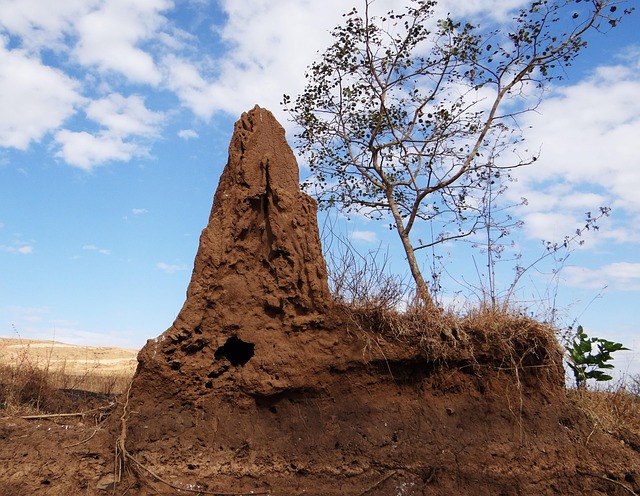Soil treatment for termites with chemical termite killers like fipronil and imidacloprid is the most common termite-removal method.
Termites can eat your home’s structural beams causing significant damage. But, which are the best home remedies for termites? One that’s effective, budget-friendly, yet safe to the environment?
In summary, the home remedies for termites (including dry wood termites) include wet cardboard, orange oil, perimeter barrier, sunlight, nematodes, vinegar, and borates.
Home Remedy for Termites
These insects, like damp wood and dry wood termites, can be challenging and expensive to control. So, how you treat the house for termites naturally?

1. Wet Cardboard Trap
Do you corrugated boxes in the storage closet or garage? Then you have a great tool to make your termite trap. Termites love water plus cellulose – so the wet cardboard (contains cellulose) will attract the termites.
- Pick several cardboard pieces (flat strips), wet the cardboard, and position where you suspect a termite colony will pass or are already settled.
- Next, termites will settle on the wet cardboard box as they feed on cellulose. Putting the cardboard bait down lures the termites to come together to a single point where you can control them.
- After the termites have steeled on the wet cellulose cardboard, pick it with the bugs and burn it outside. This will kill all the termites and their babies. Repeat this process until you can no longer see the termites moving around.
- However, the wet cardboard trap won’t remove the whole termite colony, and thus you’ll need to couple this with other termite prevention methods.
2. Orange Oil
D-limonene is an active ingredient in orange oil, and it’s highly poisonous to termites. It works, through direct contact, by breaking the termite’s exoskeletons and killing its eggs.
But orange oil can also be used in fumigation to kill termites – but works better as a spot treatment.
Orange oil is extracted from the orange peels or oranges rinds used in making several food additives and cleaning products like drain cleaners.
- If the termite inspection is costly for you, try DIY methods like sight inspections to advanced tactics, including sniffing dogs, audio detection, or bore-scope cameras.
- Apply the orange oil into termite holes and other such openings using an injecting syringe on various affected building components, including wood.
- So, you’ll inject the orange oil into the hollowed-out sections of the wood since that’s where the termites, their eggs, and babies live.
- But be cautious as orange oil can irritate your eyes and skin – it must also not be ingested as it may lead to lung irritation.
- However, for fumigation, double bag any edibles in the house, including pet food, before you commence the termite treatment process.
3. Perimeter Barrier
This involves creating a perimeter barrier against termites to protect your home and other built structures. Ideally, the perimeter barrier should have been made during the house building process.
- However, if not, you’ll require to install your won barrier despite it being labor-intensive.
- Jig small trenches around the house on the ground where you’ll put your barrier.

Image Source: PestSolutions365
- Next, apply the right termite treatment in the barrier trenches, and this will protect your structures against subterranean termites.
4. Vinegar for Termites
Vinegar is an excellent home solution for controlling household and other termites. Mainly, this solution is used in cleaning showers or kitchen counters.
EPA outlines that nematodes are very effective in controlling termites in the lab. Vinegar is acidic, and thus it’ll kill the termites readily on contact – but you’ll need to spray regularly.
- Mix lemon juice (from 2 lemons) with 1/2 full cup of the vinegar. Now, put the “juice” into the spray bottle since it allows easier dispensing on termite-infested spots.
- Spray the Vinegar-lemon mixture on termite mounds and hole entrances that are in or around your house. Spray on garden fences, wooden structures, plus corners of different structures.
- Allow the vinegar mixture to slowly seep into the holes and cracks to kill the nasty termites.
- After 3-7 days, conduct a termite inspection to see if the bugs have died. Repeat the treatment if you notice signs of termites or their babies.
5. Beneficial Nematodes
Nematodes enter the termite’s body and start feeding on its blood and muscles. The parasitic roundworms release bacteria, and this causes blood poisoning for the termites, causing death. Nematodes are effective in killing termites.
You can purchase beneficial nematodes in different local or online stores to control invasive termites. Once the termite dies, the nematodes continue multiplying and move onto their next host and poison it to death.
- Mix the nematodes (the microscopic roundworms) with some water. But first, requirements are nematodes, water, spraying bottle, stirring stick, and bowl.
- Fill the bowl with water and pout the nematodes into it, ready to control the nematodes. Use the stirring stick to mix up the nematodes with the water. Leave for 5-10 minutes.
- Put the nematode-water mixture into some spraying bottle and spray on places with a termite infestation or passing routes. Begin spraying from your backyard.
- Ensure your spray holds the highest pressure, as this will help prevent blockage. Shake your sprayer while continuing with the spraying to prevent the nematodes from settling at the bottom of the bottle.
Caution: Spray at sunset or early morning as this is when the nematodes will be highly active. Further, the ground temperature must be below 60⁰F to prevent nematode death.
- One package of nematodes can treat an area of about 1,600 square feet for termites. The nematodes will be in powder or granule form to allow easier mixing and dissolving.
6. Borates
Borax powder (Sodium borate) is mainly used as a laundry cleaner, but it’s also an effective home remedy for controlling termites. You can mix the borax with water and spray or sprinkle the powered around the house – see this guide.
- Borates applied on the foundation penetrations, expansion joints, plumbing penetrations, concrete, and wood surfaces will penetrate and offer extended termite control. Keep the surfaces sealed to protect them from moisture.
Disodium octaborate tetrahydrate (DOT) is the chemical component of borates is safe for plants and humans but relatively toxic to fungi and insects.
Conclusion
Besides the home termite control methods outlined above, I recommend taking preventive measures against the bugs and their babies.
Keep any cellulose, cardboard, firewood, or wood away from the house as they tend to attract termites into the yard and home. Also, ensure adequate drainage and excellent ventilation for the interior and exterior of your house.
